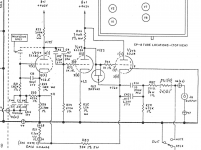If I have a small hum in 1 channel of a line stage, then if the heaters are shared across the valves (each dual triode drives both left and right) can I assume it can't be the heaters as a source of the hum in 1 channel.
That's my logic - is this sensible?
That's my logic - is this sensible?
Probably, though the wiring could be asymmetrical, or the twisting could be different.
Thee are so many things not in the schematic that logic sometimes doesn't help that much.
Thee are so many things not in the schematic that logic sometimes doesn't help that much.
Last edited:
Hum in valve amps can come from many sources.
1/ Input not screened.
2/ Interference into input from magnetic fields or close HV signals.
3/ Some people insist on DC heaters but I havent found a need for that. In my experience hum usually comes from elsewhere.
4/ Switching spikes from rectifiers.
5/ Poor power supply track routing causing charging impulses to modulate ground line.
6/ Lack of star grounding.
etc etc
1/ Input not screened.
2/ Interference into input from magnetic fields or close HV signals.
3/ Some people insist on DC heaters but I havent found a need for that. In my experience hum usually comes from elsewhere.
4/ Switching spikes from rectifiers.
5/ Poor power supply track routing causing charging impulses to modulate ground line.
6/ Lack of star grounding.
etc etc
Probably, though the wiring could be asymmetrical, or the twisting could be different.
Thee are so many things not in the schematic that logic sometimes doesn't help that much.
Thanks - the valves in question are 2 12AX7 and then 1 6DJ8.
The 12AX7s share a 24V in series DC heater and the 6GJ8 an AC 6.3V so my simple logic was if the same current is going through 12AX7 and passing though left and right triode it can't be the heater supply. As far as the AC in the last 6DJ8 then I guessed the same logic.....
Hum from heater are typically power line frequency (60Hz in US). Hum from rectified DC (most other hum source) are typically 2X that 120Hz. Use a scope or play some 60/120 wav file to train your ear to debug it that way. Hum problems are hard (and take time) to solve, good luck and have patient!
Yes, post photos of your layout and hum waveforms, and the schematic.
If you ground the grid of the 6DJ8 and the hum goes away, it's in the 12AX7 stage.
If you ground the grid of the 6DJ8 and the hum goes away, it's in the 12AX7 stage.
Yes, post photos of your layout and hum waveforms, and the schematic.
If you ground the grid of the 6DJ8 and the hum goes away, it's in the 12AX7 stage.
I like this logic a lot, so presumably the same is true at each stage to find the source in each of the 2 12AX7s?
Here is schematic
I have swapped channels, valves and leads and it's in the LH line stage after the pot into V4 (12AX7) and then into V5, and V6, if I mute after V6 it disappears obviously 🙂
Attachments
You could short the grid of the SECOND 12AX7 to ground, and if the hum is gone,
the hum is from the first stage.
DO NOT ground the grid of the 6DJ8 in this circuit, since it is at an elevated DC potential.
Has this circuit ever been hum-free? It's the standard line stage that ARC had used for many years.
the hum is from the first stage.
DO NOT ground the grid of the 6DJ8 in this circuit, since it is at an elevated DC potential.
Has this circuit ever been hum-free? It's the standard line stage that ARC had used for many years.
Last edited:
tried the earth into the grid of V6....YIKES massive scary POP.
normal mute circuit then gave a loud pop on mute and so I turned it off, waited turned it back on and it seems ok!!
Any other ideas, less dramatic!!
normal mute circuit then gave a loud pop on mute and so I turned it off, waited turned it back on and it seems ok!!
Any other ideas, less dramatic!!
You could short the grid of the SECOND 12AX7 to ground, and if the hum is gone,
the hum is from the first stage.
DO NOT ground the grid of the 6DJ8 in this circuit, since it is at an elevated DC potential.
Has this circuit ever been hum-free? It's the standard line stage that ARC had used for many years.
I tried shorting the grid after the 1K and this created a large hum?
Maybe I should first of all return to the question on heater circuit logic....can I ignore this as a source as it's only in 1 channel and the valves share the supplies?
- Home
- Amplifiers
- Tubes / Valves
- Quick question on basic Logic :-)
